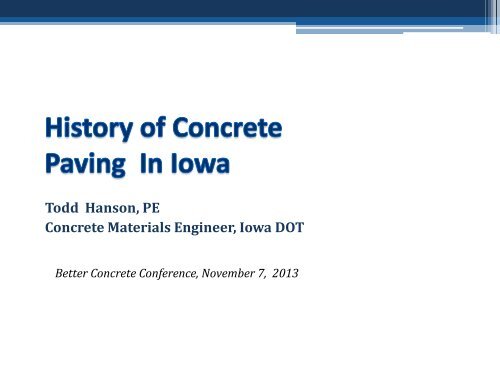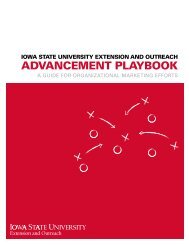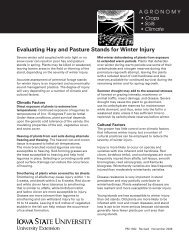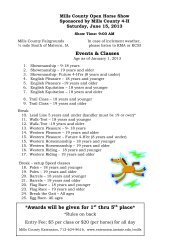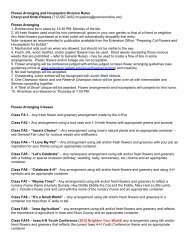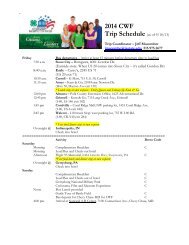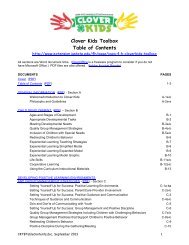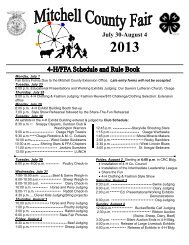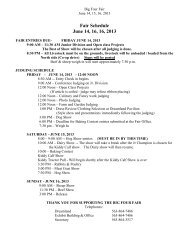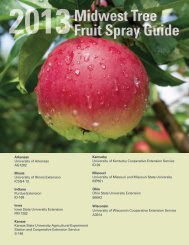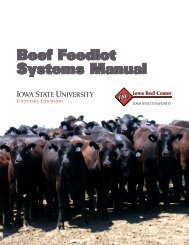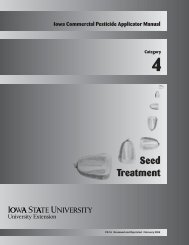History of Concrete Paving In Iowa - Iowa State University Extension ...
History of Concrete Paving In Iowa - Iowa State University Extension ...
History of Concrete Paving In Iowa - Iowa State University Extension ...
You also want an ePaper? Increase the reach of your titles
YUMPU automatically turns print PDFs into web optimized ePapers that Google loves.
Todd Hanson, PE<br />
<strong>Concrete</strong> Materials Engineer, <strong>Iowa</strong> DOT<br />
Better <strong>Concrete</strong> Conference, November 7, 2013
<strong>In</strong>tro<br />
• <strong>Iowa</strong> has a rich history<br />
<strong>of</strong> concrete paving<br />
• Explore how we got<br />
here<br />
• Changes in the last<br />
100 years
<strong>Concrete</strong> Pavement-Gets<br />
<strong>Iowa</strong> Out <strong>of</strong> the Mud<br />
• <strong>In</strong>terest <strong>of</strong> public<br />
mud, dust, deep sand<br />
• Natural resources<br />
▫ Northwestern 1908<br />
▫ Hawkeye 1910<br />
▫ Lehigh 1911<br />
▫ Dewey 1927<br />
• Royalty fee for<br />
asphalt
1904 1st <strong>Concrete</strong> Pavement in <strong>Iowa</strong><br />
• First Street (Eagle<br />
St) in Lemars <strong>Iowa</strong><br />
• 2 nd oldest concrete<br />
street in America<br />
• Two businessman<br />
fed up with dust<br />
when dry & mud<br />
when wet
1904 1st <strong>Concrete</strong> Pavement in <strong>Iowa</strong><br />
• Two lift construction similar to<br />
sidewalk construction at the<br />
time (½” surface )<br />
• 5” lean base, 1 ½” surface with<br />
significantly higher cement<br />
content<br />
• 6ft diagonal panels scored 4<br />
inch squares to prevent horse<br />
slipping
1909 - Eddyville Cemetery Rd<br />
• Oldest Farm to<br />
Market Road in <strong>Iowa</strong><br />
• Top 10 oldest in<br />
America<br />
• Citizens fed up with<br />
deep sand during dry<br />
weather
1913 -<strong>Iowa</strong> Highway Commission<br />
Several Short Projects Built<br />
• Cerro Gordo<br />
• Louisa<br />
• Benton<br />
• Dallas<br />
• Muscatine (1914)<br />
Moscow Road – 2011 ( 16 ft. wide, 25 ft joints)
1917 - <strong>Iowa</strong> FA-1 Cerro Gordo Co.<br />
Specifications<br />
• Type A (FD) or Type B (two<br />
coarse)<br />
• 1 st penalty clause<br />
▫ Divide into 50 ft blocks<br />
▫ Count bags <strong>of</strong> cement<br />
▫ If any 3 adjacent blocks 4%<br />
less or 7 1/2 % more,<br />
remove and replace the<br />
blocks<br />
• Surface struck with template or<br />
strike board - No limitations<br />
• Texture 3 -ply belt 10” wide<br />
• Curing 1 day wet burlap/10<br />
days wet earth<br />
Federal Aid Project No. 1 -1917<br />
6” thick, 16ft wide w/ ½” square<br />
transverse bars every 15’ 1”
1918 – Seedling Mile<br />
• Linn County<br />
• Northwestern <strong>State</strong>s Cement<br />
donated 3,000 barrels <strong>of</strong><br />
cement<br />
• Ford <strong>Paving</strong> Company bid <strong>of</strong><br />
$3.15/yd 2<br />
• Highway Comission talked them<br />
down to $2.84/yd 2<br />
▫ Changed to Muscatine Gravel<br />
▫ Changed from Type B (two<br />
course) to Type A (single<br />
course)
Mixing -Early Steam Mixers<br />
• Not self propelled<br />
• Mix by Volume 1:2:3<br />
▫ 1.7 bbls / yd3<br />
• 94 lb bag = 1ft3<br />
• Aggregates -<br />
proportioned by<br />
bottomless 1 ft3 box<br />
in wheelbarrow<br />
▫ Marked a line<br />
• Bulking effect<br />
• Counted shovels<br />
when less inspection<br />
• Water by sound
Preparation <strong>of</strong> Subgrade<br />
• 1920’s<br />
• Sprinkle with water<br />
uniformly moist or<br />
cover with tar paper<br />
• Plastic 1960
1921 - Woodbury US 20<br />
• By 1921, development <strong>of</strong><br />
tools & equipment to<br />
reduce back breaking<br />
labor<br />
• Cranes with clam shells<br />
buckets unloaded<br />
aggregates from rail cars<br />
into bins<br />
• Dumped into single batch<br />
trucks
Materials Delivered by Truck<br />
• Dry materials dumped into<br />
skip hoist
Cement Bags Dumped on Aggregate in Skip
Other Method - <strong>In</strong>dustrial Rail Cars
Mixer<br />
• Self propelled<br />
• Water lines laid out<br />
along grade<br />
• <strong>Concrete</strong> deposited by<br />
swinging boom &<br />
bucket
Finishing Machine<br />
• Operated on steel forms<br />
• Machines had tamping bar &<br />
two opposed adjustable<br />
oscillating transverse<br />
screeds<br />
• Most popular brands –<br />
Lakewood and Ord
Longitudinal Finishing<br />
• 12 foot by 12<br />
inch wide by 3<br />
inch thick<br />
wood float<br />
• Combined<br />
longitudinal<br />
and transverse<br />
motion across<br />
surface
Belting Surface<br />
• Use combined<br />
transverse and<br />
longitudinal motion<br />
with a minimum 8<br />
inch wide belt<br />
across the surface<br />
to remove tool<br />
marks and produce<br />
a gritty texture
Curing 1 day Wet Burlap
7 day -2” <strong>of</strong> Wet Earth Cure
Old US 20 -2009<br />
Old US 20 – 8 “ Thick- 16 ft wide No joints
Alternate<br />
Curing<br />
Methods<br />
Curecrete<br />
Ponding
Longitudinal Joint<br />
• Prior to 1920 transverse joints<br />
12 to 35 ft intervals<br />
• 1920 to 1925 – No transverse<br />
or longitutinal joints<br />
• 1925 to 1929 – Steel or mastic<br />
longitudinal joint, No transverse
Expansion Joints<br />
• 1930 & later – transverse<br />
expansion joints 80 to 100 ft<br />
intervals
1924 - US 20 Woodbury<br />
Batching <strong>Concrete</strong> by Weight
1925 - Mixing by Weight<br />
• Variable concrete produced<br />
due to sand bulking - moisture<br />
variations<br />
• Roy W. Crum, Materials & Tests<br />
Engineer considerable work on<br />
concrete proportioning<br />
• 1924 research proved weight<br />
was more reliable method<br />
• 1925, Highway Commission<br />
specified weight measurement<br />
• Became the universal standard<br />
method worldwide
1925 Gas / Diesel Mixers<br />
• Steam mixers<br />
retired<br />
• Powered by gas or<br />
diesel fuel
Bulk Cement in<br />
Rail Car<br />
• Bulk cement became<br />
available in the early<br />
1930’s<br />
• Cement batching<br />
plants eliminated<br />
the use <strong>of</strong> bags<br />
Bulk cement – Howard Co. 1931
1933 - Smoothness<br />
• 1921 to 1933<br />
▫ 1/4” in 10 ft.<br />
• 1933 to 1976<br />
▫ 1/8” in 10 ft.<br />
• Correction with<br />
carborundum brick
1937 - Vibration<br />
• Operated at no less than 3,500<br />
vpm’s
1952 – <strong>Concrete</strong><br />
Air Entrained <strong>Concrete</strong><br />
• 1952 3-5%<br />
• 1956 4-6%<br />
• 1960 6±1%<br />
Mix Design<br />
• Absolute volumes similar to<br />
Class C mixes
Early 1950’s – Center Parting Strip<br />
• Continuous inserted parting strip<br />
• Tended to wander<br />
• Air entrained concrete stickier<br />
• Longitudinal finishing removed<br />
from required equipment
1956<br />
• Sawing <strong>of</strong> transverse<br />
longitudinal joint<br />
required
Development <strong>of</strong><br />
Slip Form Paver<br />
• 1947 – James Johnson & Bert<br />
Myers Office <strong>of</strong> Materials<br />
conceptualized extrusion<br />
process<br />
▫ 18” wide / 3” thick sidewalk<br />
• 1948 - Improved prototype<br />
produced 4’ wide 5” thick<br />
sidewalk<br />
• 1949 – Full scale prototype<br />
placed 1 st slip form pavement in<br />
Obrien & Cerro Gordo county<br />
▫ Two 10ft passes<br />
▫ 3-4” gap filled with AC
Development <strong>of</strong> Slip<br />
Form Paver<br />
• Little advancement until 1954<br />
• Greene county wanted to try<br />
slip form<br />
• Leased to Ray Andrews<br />
• Andrews removed the hopper<br />
and deposited concrete on the<br />
grade in front <strong>of</strong> the paver as is<br />
done today<br />
• Gap was filled with concrete
1955 - 1 st Commercial Slip form paver<br />
• Quad City slip<br />
form paver<br />
• Soon other<br />
manufacturers<br />
followed<br />
• Became the<br />
standard method<br />
<strong>of</strong> placement
Ist Slip form on <strong>In</strong>terstate I80 <strong>Iowa</strong> Co 1964<br />
• <strong>In</strong> <strong>Iowa</strong>, slip form paving on interstate and primary paving would not<br />
become as predominant as it is today until the late 1970’s and early 80’s<br />
• Central batch mixing also used on this project and became more<br />
predominant during construction <strong>of</strong> the interstate<br />
• 27E, 31E & 34 E batch mixers retired
Pavement Design<br />
• Uniform depth until 1926<br />
• Thickened edge design 1926-<br />
1957<br />
• 18ft wide until mid-1930’s<br />
• 20ft wide until 1948<br />
• 22 ft wide until 1959<br />
• Steel – alternating sides across<br />
longitudinal joint<br />
• Expansion joint with load<br />
transfer every 80 to 120 ft
1950’s - Pavement Widening<br />
• Narrow widths placed<br />
• Upgrading to modern<br />
standards<br />
• Numerous curb removal<br />
widening projects during<br />
the 1950’s
Load Transfer<br />
• 1958 to 1969 – 20 foot joint<br />
spacing with aggregate interlock<br />
• Load transfer<br />
▫ ADTT >500 -1969<br />
▫ ADTT>300 -1995<br />
• Joints perpendicular until 1980<br />
• Skewed 6:1 1981 to 2004<br />
• Perpendicular 2005<br />
• ATB or CTB subbase specified<br />
ADTT>700 1976 to 1981<br />
• Granular subbase 1989<br />
• ADTT>300 1995
1958 – <strong>In</strong>terstate <strong>Paving</strong><br />
• 1958 to 1966 jointed<br />
reinforced<br />
• 76.5’ joint spacing<br />
• Mesh reinforced<br />
• Tandem pavers<br />
▫ Bottom lift placed<br />
▫ Place mesh<br />
• Top layer placed by<br />
second paver
<strong>In</strong>terstate CRC <strong>Paving</strong><br />
• 1966 - Early CRC was placed on<br />
chairs<br />
• 8 inch thick on<br />
▫ Granular subase 1966-1967<br />
▫ ATB or CTB 1968-1976
<strong>In</strong>terstate CRC paving<br />
• <strong>Iowa</strong> First - 1967<br />
• Steel fed through machine – No<br />
transverse steel<br />
• Bottom layer placed<br />
• Steel placed on top<br />
• Second paver pass<br />
• Problems because steel not<br />
placed at central axis.
1960’s -<strong>Iowa</strong> Special<br />
Trimmer/Placer<br />
• Allowed full width placement<br />
on county roads with minimal<br />
working area<br />
• Conveyer attached to trimmer<br />
• Trucks placed material on<br />
conveyer<br />
• <strong>Concrete</strong> deposited over the top<br />
on the trimmed subgrade
1971 – Aggregate<br />
Durability Classification<br />
• 1920’s Pit run gravels used<br />
• Coarse & fine aggregate<br />
• 1930’s few limestone sources<br />
▫ Alden - good<br />
▫ Glory – bad<br />
• 1950’s more sources – interstate<br />
▫ Bethany Falls / Argentine<br />
• 1971 Class 2 – <strong>Paving</strong>, Class 1<br />
Structures<br />
• 1982 Class 3 <strong>Paving</strong>, Class 2 other<br />
pavements<br />
• 1992 Class 3I – 40 year design life<br />
• Unique system today - <strong>Iowa</strong> Pore index<br />
test & chemical testing <strong>of</strong> aggregates
<strong>Concrete</strong> Overlays<br />
• <strong>Concrete</strong> overlays are not new<br />
in <strong>Iowa</strong><br />
• Several overlays (resurfacing)<br />
projects were placed in the<br />
1930’s to 1950’s<br />
• 1960 Woodbury County over<br />
asphalt<br />
▫ Gravel interlayer<br />
• 1971 Storm Lake Airport on<br />
asphalt<br />
US 30 Benton Co 1949 - 6 inch PCC resurfacing
Modern<br />
<strong>Concrete</strong> Overlays<br />
• 1973 Greene County<br />
• Bonded and un-bonded sections<br />
placed<br />
• Steel fibers<br />
• CRC & mesh Reinforced<br />
• 1976 – Woodbury & Blackhawk<br />
thin bonded overlays<br />
• 1977 – Boone, Dallas,<br />
Washington counties placed<br />
whitetopping overlays<br />
• <strong>Iowa</strong> county road system has<br />
placed as many miles <strong>of</strong><br />
concrete overlays as the total in<br />
the USA
1976 - Tining<br />
• Guidelines for Skid-Resistant<br />
Pavement Design published by<br />
AASHTO in 1976 to provide safe<br />
wet weather friction<br />
• Accomplished by turf or burlap<br />
drag and ¾” spaced transverse<br />
tining<br />
• 1999 changed to longitudinal<br />
tining – improved noise<br />
characteristics
1977 – Recycled<br />
Aggregates<br />
• Existing pavement recycled as<br />
coarse aggregate<br />
• US 75 Lyon, IA 2 Taylor, I-680<br />
Pott.<br />
• Class 2 or better Aggregate<br />
sources<br />
▫ 1979 - 191 sources<br />
▫ 2012 - 298 sources
Water Reducers<br />
& Fly ash<br />
• 1974 Water reduced mix<br />
designs C-3WR & C-4WR<br />
• 1978 -1 st use <strong>of</strong> fly ash<br />
Woodbury & Monona Co.<br />
• 1984 – Contractors Option<br />
▫ 15 to 20%<br />
Woodbury County - 1978
Smoothness<br />
• 1977 Correction <strong>of</strong> high spot by<br />
diamond grinding<br />
• 1981 -1 st use <strong>of</strong> the California<br />
type, 25 foot pr<strong>of</strong>ilograph<br />
• 100%
Maturity Method to<br />
Determine Opening<br />
• Prior to utilizing maturity<br />
method – opening strength<br />
determined by beam break and<br />
5 to 7 days<br />
• 1995 Research in Lee County<br />
• 1997 -Contractor’s option to<br />
use maturity method <strong>of</strong> opening<br />
• <strong>Iowa</strong> one <strong>of</strong> the first states to<br />
implement the method for<br />
opening
Slag and<br />
Blended Cements<br />
• First use <strong>of</strong> slag in project 1995<br />
▫ Linn Co IA 100<br />
• Type IS cements with fly ash<br />
• Type IP cement 1995<br />
▫ I-29 Pottawattamie Co<br />
• Type IP cements with fly ash<br />
• <strong>Iowa</strong> most miles <strong>of</strong> ternary<br />
mixes in the country<br />
▫ 600 miles slag & fly ash<br />
▫ 225 miles IP & fly ash
Stringless <strong>Paving</strong><br />
• Washington county research<br />
2003<br />
• Developmental Specification<br />
2011
Conclusions<br />
• <strong>Iowa</strong> has been a leader in a number <strong>of</strong> concrete paving<br />
achievements<br />
▫ Batching by weight<br />
▫ Slip form paver<br />
▫ Overlays<br />
▫ Maturity Method<br />
▫ Ternary mixes<br />
• Many changes occurred in the last 100 years<br />
• Learned from mistakes and capitalized on successes<br />
• Partnership with industry has been a key to success
Structures – <strong>Iowa</strong> Firsts<br />
Questions<br />
1893 – Lyon County - First reinforced<br />
concrete bridge in the United <strong>State</strong>s<br />
1963 – <strong>Iowa</strong> Method <strong>of</strong> Low Slump,<br />
dense <strong>Concrete</strong> Bridge Deck Overlay


